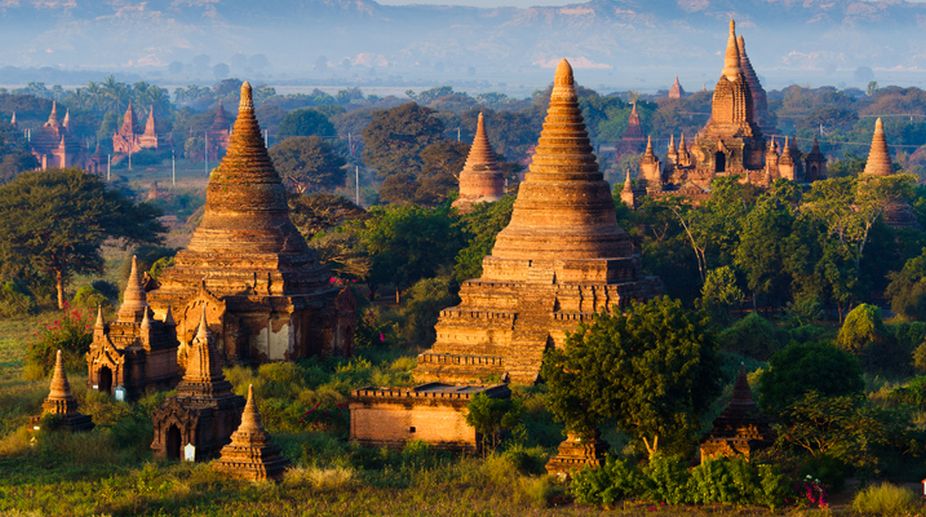On the way from Mingaladon Airport to the downtown hotel, I caught a fleeting glimpse of the Shwedagon Pagoda basking in the sun. Later, I saw the well-lit pagoda towering over Yangon's night-time skyline from the hotel terrace. It gave a surreal optical impression of a huge radiant rocket about to lift-off to the heaven. But nothing quite prepared me for the dazzling brilliance of the surreal, gold plated gorgeousness of the Shwedagon pagoda — Myanmar’s most arresting and memorable symbol.
The next morning, at Shwedagon Paya (pagoda), after leaving my floaters down below, I walked the stairways to its elevated courtyards. I walk slowly, in tune with the men and women who came to offer alms and food to Lord Buddha. They circle around the main stupa, occasionally stopping to pay their prayers in hundreds of small and big ornate temples and shiny shrines surrounding it. There is an air of mildly frenzied festivity. The stunning main stupa, with outer layers fitted with real gold leafs and plates with diamonds on its crest, rises in the sky above all this religious bustle.
Advertisement
The atmosphere felt strange and exotic. I moved to a quiet corner shaded by a banyan tree. The sight took me by surprise — I was in awed into silence. From where I watched the people floating by, I felt the pulse of a community and sensed their feeling of joy. I fully understood why the Shwedagon pagoda is called the heart of Myanmar, the soul of its people.
As Yangon’s public buses use only Burmese signage, one had to always use taxis and incidentally, taxis are cheap and comfortable. Most of them (and other cars) are refurbished second hand Japanese Toyotas or other brands. An English speaking driver, however, is worth its weight in Kyats! One also noticed, with some amusement, that Myanmar is the only country where cars are right-hand driven when they drive on the right hand side of the roads as well.
Yangon is dotted with numerous pagodas of varying sizes and colours. Three of them are in the not-to-be-missed category. One of them, Sule Pagoda, is located so centrally that one can’t miss it, even if they try. The other two are located on opposite sides of the city. The architecture of Chaukhatgyi Paya is not that impressive but nothing can beat the dramatic sense of its huge reclining Buddha. All walls of the Botatung Paya is layered with gold leafs. The pagoda was built to house the hair and other relics of Lord Buddha, which can now be seen behind glass around each turn of the golden labyrinth that zig-zags around the inside of the hollow stupa.
Because of Myanmar’s self imposed seclusion, Yangon itself is relatively unknown to most outsiders. So, I decided to explore the city a bit to understand its history and culture. For this, I walked around its streets quite often, occasionally hiring pedaled trishaws that has passenger’s seat on one side.
The British built the inner city as venues for business and government administration and that meant buildings with solid structures incorporating the grace-notes of Empire — neo-classical columns, roseate windows, cupolas and colonnaded balconies. Some of these buildings, particularly around the iconic Strand Hotel, have been renovated and painted to their former glory. But just beyond, the rest of the inner colonial Yangon is a study in splendour going to seed. Once-elegant apartments teem with tenants, there’s plaster peeling away, Doric columns leaning awry and graceful curlicues chipped. Moss and mold of many a monsoon are seen sprouting from the masonry.
Yangon’s footpath is always busy with locals immersed in their daily business. While the women wear tightly wrapped coloured sarongs, men are happy with lose longyi, often as office attire. Faces of most women and kids are smeared with yellowish patches of thankha, which acts as cooling agent-cum-sun blocker. A large number of colourfully robed monks and nuns are part of the scene everywhere. It is obvious that religion plays a big part in the social fabric. So, unlike other South-east Asian cities, nightlife, especially naughty ones, are virtually non-existent.
I suggested to my Croatian travel-mates, Boris and Claudija, to join me for visiting Indiatown and its temples in the evening. I had a hidden agenda of seeing first-hand the miniscule Indian, particularly Bengali, community in Myanmar. During the British times, Yangon had more Indian than Burmese inhabitants. But, after its independence, locals took their revenge by confiscating and nationalising Indians’ business and properties or cancelling their citizenships, thereby forcing them to leave the country. Some tenacious non-Burmese hung on and are now found in Yangon’s Chinatown and Indiatown. Now, most of their descendents have become fully indigenised and use Burmese languages and names.
We found the Kali Bari had South Indian type ornate temple architecture and is run by multi-ethnic Indian community. The Durga Bari, on the other hand, is mainly a Bengali-run affair. One felt lucky, as during my visit, a consecration ceremony of the new idol was going on and about one hundred local Bengalis were present. Most of them had never visited West Bengal but heartily welcomed me with a ceremonial dinner. Their warmth was so real that it even my Croatian travel mates were greatly touched.
Yes, Yangon is different but in a really interesting way. The city is not just teeming with magnificent sights but also reveals different layers of Myanmar’s history and culture.











